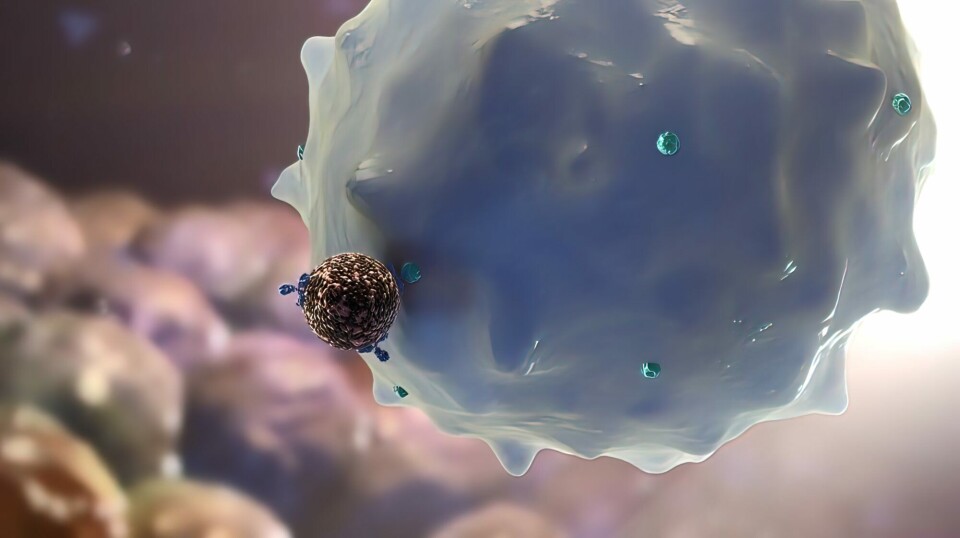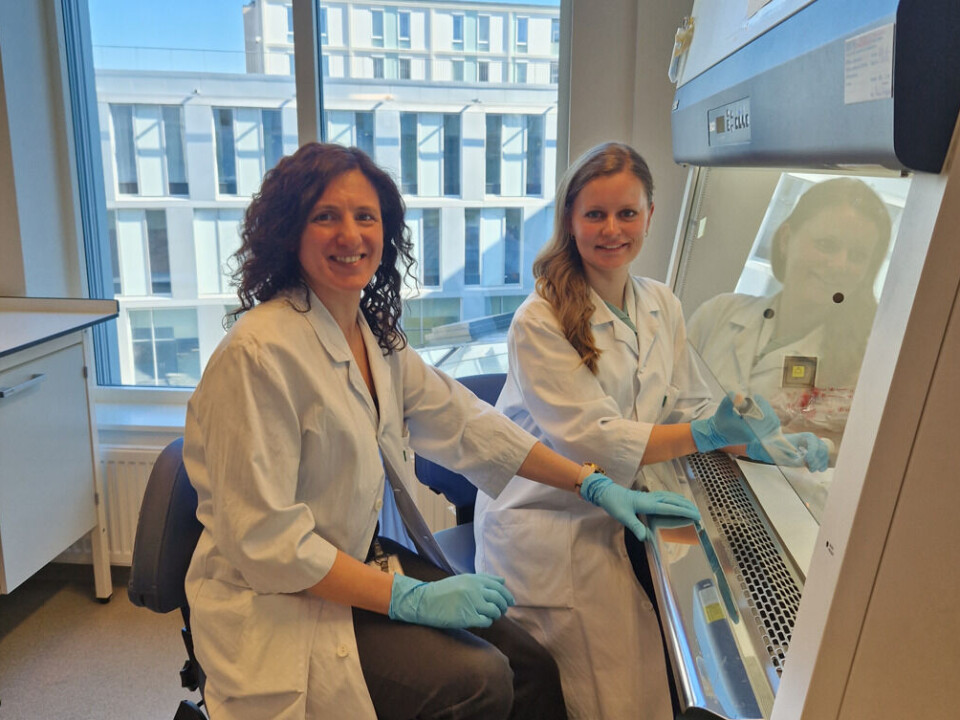THIS ARTICLE/PRESS RELEASE IS PAID FOR AND PRESENTED BY SINTEF - read more

Researchers are attempting to use a patient’s immune cells to prevent the spread of cancer
In nanomedicine, there has long been an issue where the immune system captures and destroys nanoparticles and the drugs they carry. Now, researchers are attempting to exploit the problem to their advantage in the fight against cancer.
Researchers around the world are seeking to identify techniques that use nanoparticles in the treatment of disease.
Such particles are about 100 nanometres – one thousandth of a millimetre – in diameter. Within them, researchers are inserting large numbers of even smaller drug molecules.
There has been particular optimism in the treatment of various forms of cancer.
“We’ve observed that blood vessel walls in cancer tumours in mice have larger pores than the same vessels in healthy tissue. If we inject nanoparticles into the blood, the pores make it easier for them to escape from the vessels and enter the tumour,” Sjoerd Hak says.
He is a researcher at the research institute SINTEF.
“In healthy tissue, where the blood vessels are intact, the nanoparticles cannot escape,” Hak adds.

Consequently, it becomes easier to deliver the medication to the desired destination while limiting its uptake in parts of the body where it may potentially cause harm.
However, nanomedicine faces a major problem: Our immune systems do not welcome small and unfamiliar foreign bodies.
A virus or a drug?
“The nanoparticles are about the same size as a virus and are normally made up of molecules that do not naturally belong in the blood. This means that the body will discover and remove them,” Hak says.
As a result, the nanoparticles will not be present in the blood for long enough to release an adequate dose of medication to the target tumour.
“Much of our research has been focused on developing particles that can prolong their presence in the blood. We’ve had some level of success, but drug uptake by tumour tissue still remains limited. In mice, we’ve achieved a lot of excellent results, but the effect continues to remain somewhat limited in humans,” he says.
As with so many other technologies with the 'nano' prefix, it is taking some time for nanomedicine to live up to the expectations it generated a decade or two ago.
“In relation to the extent of this field of research, very little has been achieved in terms of clinical treatments. But we will get there – I’m convinced of that,” Hak says.
In the meantime, he and his colleagues are exploring an alternative approach for nanomedicines. Instead of fighting against the immune system, they are attempting to team up with it and play along.
Aggressive immune cells
It is very difficult to prevent nanoparticles from being consumed by immune cells. Such cells are specialists in seeking out and removing foreign bodies.
However, our understanding of the role of these cells have significantly improved, leading to various new treatment methods in what is known as immunotherapy.
“We’re trying to combine these two aspects as part of our research, and we’re not the only ones. There are many researchers around the world who have realised this and who are trying to exploit interactions involving immune cells,” Hak says. “Our intention is to use the body’s own defence mechanisms to attack cancerous tumours. We’re not necessarily targeting the cancer cells directly, but we want to make conditions less favourable for their growth and development."
Targeting the drugs directly at the cancer cells is not the most important thing. The key objective here is what the drugs do when they interact with the immune cells and the immune system.

What’s going on in living tumours?
In order to achieve this, the researchers need more knowledge about what actually happens to the nanoparticles and the drug molecules they are carrying. One of the techniques they are using is called intravital microscopy.
“Intravital microscopy involves taking film and images of living tumours in mice under a microscope. This enables us to look at individual cancer cells and examine the blood vessel walls,” Hak explains.
The nanoparticles are too small to be identified in isolation, but by making them fluorescent, we can follow their movements.
“They’re too small to see individually, even under a microscope, but we know where they are because we can detect their fluorescence,” Hak says.
According to Hak, they can see the immune cells moving around and that they have taken up large numbers of fluorescent particles. Within the tumour, they can see cells that are quite immobile and which have also taken up particles.
“We can see that some immune cells actually seem to be responsible, at least in part, for the uptake of particles in the tumour. It is not possible to observe this using techniques other than intravital microscopy,” he says.
This is information that cannot be obtained, for example, through MRI or PET scanning.
“Intravital microscopy has provided us with a better mechanistic understanding of how these particles accumulate in a tumour,” he says.
Changing the behaviour of immune cells
Researchers have demonstrated that it is in fact possible to get the particles into the immune cells within the tumour. The next step is to find the right medication and, most importantly, ensure that it can have an effect in treating a disease.
The natural response of the immune cells is to attempt to destroy the nanoparticles, and they are more than adequately equipped to achieve this.
“The immune cells attempt to break down the particles. They contain a variety of enzymes and acids, as well as dedicated spaces, or compartments, where they send material for destruction,” he says.
These immune cells are what researchers call phagocytes, from the Greek meaning ‘eating cells’. Hak and his colleagues are looking to manipulate these phagocytes so that they change their behaviour.
“We’re working with two different drugs that we’ve encapsulated within the nanoparticles and are now trying to see what kinds of effects these have on the immune cells,” Hak says.
They are targeting phagocytes because these cells can ‘change sides’ and work for the cancer tumour rather than against it.
“We know that these cells play key roles when a tumour grows and develops. The tumor manages to deceive these cells into working to its advantage,” Hak says. “What we’re trying to do is manipulate or shut down the functions of these cells that work for the tumour."
Promising test results in mice
In effect, this means that researchers are attempting to increase the immune cells’ uptake of nanoparticles. This is the complete opposite of what medical research has been working to achieve for many years.
Currently, they are looking into how the process works in isolated human immune cells and in mice with breast cancer.
“We completed the first therapeutic experiments a few weeks ago, and the results are very interesting. However, there’s a lot more work to do before we can draw any conclusions. It will take time to determine exactly how we should do it, what the right concentrations are, and which incubation times are the most appropriate,” Hak explains.
He says that there is still a lot that need to be figured out before they can say that the technique works.
“Perhaps we’ll find out that it doesn’t work at all using the two drugs we’ve selected. In that case, we may have to start again from scratch with new drugs,” he says.
A key bottleneck in the process, not only for this project but for nanomedicine as a whole, is getting the particles carrying medication out of the compartments where the cells have sent them for destruction.
“It appears that the molecules we are using are able to escape. Our initial results confirm this, so I believe we will succeed, although it’s too early yet to say for sure,” he says.
Opportunities for innovative approaches
As with all other medical research, many small steps have to be taken before we can apply new treatment methods to patients. Sjoerd Hak sees this project as part of a much bigger picture.
"It would be incredibly exciting if we find something that works so well that it is worth further research on the specific nanomedicine we are developing," he says. “But from a personal point of view, I’m more interested in demonstrating that we can achieve therapeutic effects using this technique. After all, it offers opportunities for a number of new therapeutic approaches.”
Reference:
Momoh et al. Intravital microscopy for real-time monitoring of drug delivery and nanobiological processes, Advanced Drug Delivery Reviews, 2022. DOI: 10.1016/j.addr.2022.114528
See more content from SINTEF:
-
How Svalbard is becoming a living lab for marine restoration
-
New study: Even brand-new apartments in cities can have poor indoor air quality
-
Fresh hope for patients with chronic inflammatory bowel disease
-
Testing a giant ship: May take five kilometres to stop
-
A robot is helping researchers hunt for the best cancer warriors
-
Locomotives that run on diesel can be electrified





































